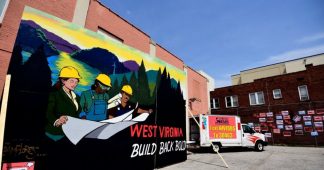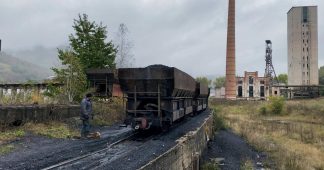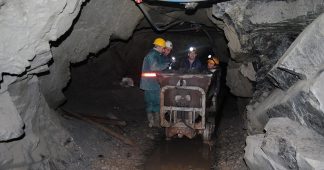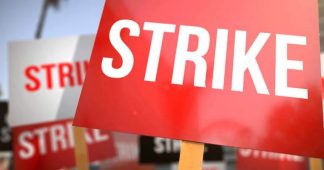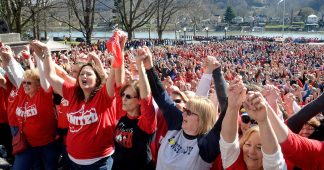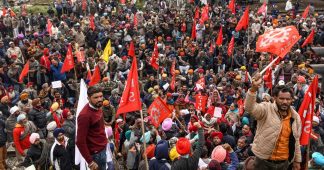By Andy Thompson, Jerry White
This month marks the 100th anniversary since the end of the Battle of Blair Mountain in 1921, when as many as 20,000 coal miners in southern West Virginia waged armed combat against a private army of gun thugs hired by the coal operators. The pitched battle lasted from August 25 to September 2, 1921, when US military forces deployed by President Warren Harding occupied the coalfields, disarming and arresting hundreds of miners under martial law.
The miners began their struggle with the express purpose of marching through Logan County, hanging the county’s notorious pro-company Sheriff Don Chafin, and moving on to Mingo County, where they would overthrow martial law and liberate their union brothers in the county jails.
In the largest insurrection since the American Civil War, the armed miners, many of whom had been drilled in military tactics during World War I and previous strikes, fought against Chafin’s Gatling guns and even aerial bombardment, leaving more than 130 killed on both sides.
The anniversary of this historic battle was hardly noted in the corporate press outside of a few articles. One in the New York Times grotesquely associated the heroic struggle of the miners a century ago with the present-day United Mine Workers of America. The UMWA, which is currently sabotaging the five-month strike by Warrior Met coal miners in Alabama, has spent the last four decades repudiating the militant traditions of the past and overseeing the obliteration of the gains won through blood.
Although everything is done to conceal the history of bitter class conflict in America and elevate race as the essential division in society, the Battle of Blair Mountain, part of the West Virginia “Mine Wars” of 1912-1921, proves that the working class has never won anything outside of unifying across all races and nationalities and waging the most determined struggle against the violent resistance of the employers and the state.
Background to the battle
The Battle of Blair Mountain was part of a wave of working-class struggles in the US and internationally, which were inspired and profoundly influenced by the October 1917 Russian Revolution. In 1919 alone, 350,000 steelworkers took part in the Great Steel Strike, 400,000 coal miners launched a nationwide strike and 45,000 workers participated in the Seattle General Strike.
The American ruling class, fearing is own “October,” responded with the first “Red Scare” and savage repression. On the second anniversary of the Russian Revolution, Attorney General Mitchell Palmer launched a series of raids across the country, rounding up more than 10,000 foreign-born workers accused of socialist, labor organizing and antiwar activity.
During World War I, southern West Virginian coal was in high demand, particularly to fuel the US Navy. President Woodrow Wilson exempted miners from the draft but insisted that they carry out increased output for the “War for Democracy.”
Wilson placed Samuel Gompers, head of the American Federation of Labor, on the Council on National Defense. The United Mine Workers union fully backed the war, with each copy of the United Mine Workers Journal including the banner: “Dig Coal! Dig More Coal! Dig Still More Coal! The Success of the War Depends on the Coal You Dig.”
When 13 West Virginia miners were killed in a mine explosion, the Journal wrote, “these local boys died in the interests of democracy, they were exerting their manpower in the production of coal with which to help win the war,” according Robert Shogan, author of the 2004 book, The Battle of Blair Mountain: The Story of America’s Largest Labor Uprising.
Indeed, throughout the war, the coal operators raked in huge profits as miners labored long hours for little pay and under the constant danger of gas explosions, roof collapses and mechanical accidents. In 1918 alone, there were 2,580 coal miners killed, including 404 in West Virginia.
Miners in West Virginia were also held under an iron fist by the coal operators and judges, police forces and politicians they controlled. The state was often referred to as “Czarist Russia” and the mine guards as “Cossacks.”
The miners lived in company towns, where nearly everything—from their shanty cabins, which lacked heat and plumbing, to the stores they bought their goods from—was owned by the mine operators. Often workers would be paid not in US dollars but in a company-issued scrip, only redeemable at company stores where high prices would eat up all the miners’ wages. When miners brought the coal they dug to be weighed, they were cheated on the scales like black sharecroppers with their cotton.
The mine owners paid the salaries of county sheriffs and their deputies to guard their properties, collect rents from miners in company housing, assault pro-union miners and kill or run out of town union organizers. In addition, they hired gun thugs and spies from the Baldwin-Felts Detective Agency, whose agents were also sworn in as law enforcement officials.
The role of these repressive forces in the run-up to the Battle of Blair Mountain was described by David Alan Corbin, the author of the 1981 study, Life, Work and Rebellion in the Coal Fields:The Southern West Virginia Miners, 1880-1922.
Hundreds of mine guards and deputy sheriffs patrolled the roads and railroads and roamed the towns on foot and on horseback, carrying shotguns, rifles, pistols, blackjacks, and clubs, while they searched for union organizers and union miners. Gatling guns, stored in the basements of company stores, were immediately placed on top of the store and coal tipple at the first sign of labor strife…
Not only were free speech and public meetings forbidden, but the miners were not allowed to congregate in groups of more than two. Mail continued to be scrutinized, read, and sometimes censored by the company-store postmasters. As an added measure of protection, the companies, around 1913-14, began to enclose their towns with barbed-wire fences in an effort to wall out the UMWA.
Miners were forced to sign “yellow dog” contracts that bound them not to become members of the UMWA or any other labor organization or even “aid, encourage or approve” of such an organization. Workers found in violation or even suspected of union sympathies were fired and forcibly evicted from their company-owned homes.
Despite attempts by the coal operators to divide workers along racial and ethnic lines, the workers of West Virginia, a mix of mostly Italian and Hungarian immigrants, white Appalachian natives and former black sharecroppers from the Deep South, stood together against the capitalist class.
During the Paint Creek-Cabin Creek strike of 1912-13, Corbin explained, miners “met the trains that were bringing strikebreakers to the strike zone and forced the potential scabs to evacuate—an action that often pitted black strikers against black strikebreakers and immigrant strikers against immigrant strikebreakers. The solidarity of black and white, Protestant and Catholic, immigrant and native miners was unbreakable.”
The Paint Creek-Cabin Creek strike, which took place just southeast of Charleston, was a significant breakthrough. The miners fought a 15-month battle against the Baldwin-Felts thugs, who built an armored train to machine-gun the tent colonies of the evicted striking miners. The coalfields were occupied by state militia, who carried out mass arrests, including of miners’ leader Mother Jones, and held illegal military tribunals to “court-martial” striking miners.
Rank-and-file miners, led by 24-year-old Cabin Creek miner Frank Keeney, took the conduct of the struggle out of the hands of the conservative UMWA national leadership and turned to the Socialist Party to hold mass meetings and provide speakers. After the UMWA announced a deal with the governor to end the strike without winning the major demand for union recognition, the miners declared that the UMWA leaders did not represent them and resumed their strike. As public exposure of the brutality of martial law rule grew, the operators finally conceded, and the miners of Kanawha and New River coalfields won union recognition.
After the strike, however, the coal operators were determined to smash the union. One Logan County operator expressed the fear that the miners wanted to “take possession of the mines themselves. … In a word, to establish a soviet government. Lenin and Trotski demanded no more.”
The Matewan Massacre
In May 1920, tens of thousands of nonunion West Virginia miners, who had stayed on the job during the 1919 national strike, signed on to join the UMWA, hoping to stand together in the next national strike. Any miner found to have joined the UMWA was fired on the spot.
Once again, the coal companies enlisted the Baldwin-Felts Detective Agency, which sent Lee and Albert Felts, the brothers of the agency’s founder Thomas Felts, to personally oversee the unionbusting efforts. The gun thugs immediately evicted workers and their families from company-owned housing.
The agents met with immediate resistance from the miners and their supporters, including Sid Hatfield, a former miner and the chief of police in Matewan, West Virginia, along with the town’s Mayor Cabell Testerman. On May 19, 1920, Hatfield, Testerman and an assembly of armed and deputized miners sought out Felts and his agents to enforce an arrest warrant and take them into custody. When confronted, Felts claimed to have an arrest warrant for Hatfield.
Witnesses reported that Testerman examined the supposed warrant and after proclaiming, “It’s bogus,” he was immediately shot dead by Albert Felts. Hatfield and the miners returned fire, and by the time the shooting ended nine of the 12 Baldwin-Felts agents were dead, including both Felts brothers. In addition to the mayor, two miners were killed. The clash became known as the “Matewan Massacre.”
At the behest of the mine operators, the state government brought in the state militia, removed Hatfield from office and arrested him. In the interim period before Hatfield’s trial, the southern West Virginia coalfields erupted in strikes, with at least 63 wildcats over the span of 11 months. Once again, hundreds of miners were arrested and jailed.
In January 1921, a sympathetic jury in Matewan acquitted Hatfield and 15 other men for the murder of Albert Felts. After the state legislature passed the reactionary “Jury Bill,” which allowed the judge to pick a jury from another county, another trial date was set. On August 1, 1921, as Hatfield was set to stand trial, Baldwin-Felts agents ambushed and killed him and his friend Ed Chambers at the entrance to the Mingo County courthouse in Welch. None of the assassins were ever held accountable.
The march to Blair Mountain
The news of Hatfield’s murder infuriated miners. Kenney and District 17 Secretary-Treasurer Fred Mooney hoped Governor Ephraim Morgan would intervene and agree to a deal for union recognition and the release of jailed miners in Mingo. Instead, the governor flatly rejected their appeals.
Miners, including many veterans of the Paint Creek-Cabin Creek strike, began gathering in massive numbers in the union strongholds in Kanawha and Boone counties and held mass meetings. At this point, those areas were effectively ruled by workers, with patrols on the roads and workers commandeering a range of equipment from farm trucks to machine guns to entire train lines.
A demand was raised for an armed march from their location across Logan County and into Mingo County to free the captive miners and bring justice to Don Chafin, the “King of the Kingdom of Logan.” The mine owners provided virtually unlimited funds for Chafin to assemble a private army force of 2,000 heavily armed anti-union thugs.
As word of the march spread, Chafin began bolstering defenses on Blair Mountain that included machine guns, explosives and even airplanes that would be used to drop gas grenades and bombs on miners.
Exact estimates differ, but at minimum 10,000 coal miners began their march on August 20, recruiting more workers from other counties as they went. The higher estimates conclude that as many as 20,000 miners took up arms and participated in the fighting.
What dominated the march on Logan was a spirit of class solidarity, regardless of race or nationality. They marched wearing red bandanas tied around their necks to distinguish themselves from the gun thugs, who tied white handkerchiefs to their arms. The red bandanas, no doubt associated in the minds of the miners and mine owners with revolution and socialism, ironically became the source of the term “redneck,” later used to disparage Appalachian workers as ignorant and backward.
As the miners marched, they sang together:
Every little river must go down to the sea
All the slaving miners and our union will be free
Going to march to Blair Mountain
Going to whip the company
And I don’t want you to weep after me
On August 25, the fighting kicked off with minor skirmishes. While heavily outnumbered, Chafin’s forces had dug themselves into fortified positions that allowed them to fire down the mountainside at miners from above. Miners, on the other hand, were armed mostly with simple rifles except for a few instances where machine guns were captured.
The miners, including approximately 2,000 World War I veterans, acted with military discipline, with officers from the US and Italian armies drilling the miners in shooting skills and military tactics, including how to fight machine guns. To get supplies, the strikers raided company-owned stores, while sparing independent stores or paying their owners. “At Sharples,” Corbin explained, “black and white marchers broke into the coal company’s racially segregated mess hall that was reserved for company officials and ate a meal. The company officials still at the mine did not try to enforce either class or racial policies.”
After a few days, a stalemate emerged where miners were unable to advance past the lines of machine gun fire, and the company army could not leave its defensive positions to break up the miners’ positions. It was then that Chafin’s planes began flying overhead and dropping leftover ordinance from the world war. Some miners had brought their Army-issued gas masks from Europe to the West Virginia battlefield. U.S. Army bombers also flew overhead to conduct surveillance for Chafin.
The U.S. Department of War, according to Corbin, sent Brigadier General Harry Hill Bandholtz (who had earned his credentials overseeing the suppression of resistance to the American colonial occupation of the Philippines) to meet with Keeney and Mooney. He ordered them to disperse the miners and threatened that they would be held responsible if they did not.
At a meeting in Madison, Keeney told the miners, “You can fight the government of West Virginia, but, by God, you can’t fight the government of the United States.”
The miners defied Keeney and continued their march, at one point coming within just four miles of the town of Logan. A terrified coal operator in town wired a congressman, telling him to contact President Harding and “say to him that unless he sends soldiers to Logan by midnight tonight that the town of Logan will be attacked by an army of four to eight thousand Reds and a great loss of life and property sustained.”
On September 2, President Harding (whose Secretary of Treasury Andrew Mellon owned mines in Logan and Mingo Counties) ordered out 2,500 federal troops and 14 bombers to save the coal operators and put down what his officials called “civil war” and “armed insurrection.”
As the Army forces poured in, miners initially seemed willing to continue fighting. However, Bill Blizzard, the UMWA leader who was commanding the miners in Keeney’s absence, ordered miners not to fire on the soldiers and began assisting the Army in disarming workers. Miners’ feelings were mixed. Some believed that the intervention of federal troops would help their cause and that they would be a neutral force in reconciling the conflict with the mine owners. They would quickly be disabused of such illusions.
By September 4, many miners had managed to escape by climbing down the hills and returning home. Others were not so lucky, as the U.S. Army carried out mass arrests. In total, 985 miners were taken into custody.
General Bandholtz refused miners’ requests to hold organizing meetings in the areas controlled by federal authorities and began censoring all news reports that were in any way sympathetic to the miners. New York Tribune journalist Boyden Sparkes, who was reporting from the side of the miners, had been shot twice by state militia on the last days of the battle but survived. When he attempted to publish a report of the events, the Army censor removed descriptions of the poverty conditions in the mining towns, telling him, “No sob stuff for those red necks.”
In a September 3, 1921 dispatch from Logan, the New York Times, which now feigns sympathy for the insurgent miners, praised Chafin and his gun thugs and denounced the “insurrecto” miners. “Federal troops arrived here this afternoon to relieve the weary volunteer army which for several days has been fighting the battle of law and order against the insurrection and lawlessness in the mountain region near the Logan-Boone County boundary line,” the Times reported.
The suppression of the miners would be followed by an escalation of repression and the virtual collapse of the UMWA. In West Virginia, union membership dropped from over 50,000 members to only a handful. Nationally, membership fell from greater than 600,000 to just 100,000. The UMWA would not see a revival until the mass struggles of the 1930s and the formation of the Congress of Industrial Organizations (CIO).
The lessons of the miners’ battle
There was no more militant and class-conscious section of the American working class than the miners of southern West Virginia. But the miners, like the rest of the working class, were indeed “fighting the US government” and the capitalist system it defended. And here the spontaneous militancy of the workers was not enough. What was needed was a political and revolutionary leadership.
John L. Lewis, who served as UMWA president from 1921 to 1960, was a vehement enemy of socialism. He opposed left-wing opponents within the UMWA, who as early as 1926 advanced the call for the nationalization of the coal mines and the building of a labor party to fight the assault on hundreds of thousands of jobs due to mechanization. By 1927, Lewis pushed through an anti-communist clause into the UMWA constitution.
The UMWA would play a leading role in the split with the AFL, the formation of the Congress of Industrial Organizations (CIO) and the mass struggles to organized unskilled workers in the rubber, auto, steel, meatpacking and other mass industries. The leaders of the CIO, including Lewis, sought to contain the insurrectionary movement of the working class that erupted in the mid-1930s and prevent a revolutionary challenge to capitalism.
“Unionization, as opposed to communism,” Lewis declared in 1937, “presupposes the relation of employment; it is based upon the wage system and it recognizes fully and unreservedly the institution of private property and the right to investment profit.” Appealing to the employers to recognize and work with the unions, he continued, “The organized workers of America, free in their industrial life, conscious partners in production, secure in their homes and enjoying a decent standard of living, will prove the finest bulwark against the intrusion of alien doctrines of government.”
The domination of the labor movement by an anti-communist labor bureaucracy and its political subordination of the working class to the Democratic Party would have disastrous consequences, not only for the miners but all workers. In the end, the pro-capitalist and nationalist unions were incapable of responding in any progressive fashion to the globalization of capitalist production and the loss of US economic hegemony.
By the early 1980s, UMWA President Richard Trumka and Vice President Cecil Roberts (now president) set out to destroy the militant traditions of the miners and impose a policy of “selective strikes,” which led to the isolation and defeat of the A.T. Massey and Pittston strikes and the virtual disappearance of the UMWA in its former Appalachian strongholds.
A study of the Battle of Blair Mountain is critical to dispel the lies about the supposed backwardness of the American working class and the promotion of middle-class racialist and identity politics. As a new generation of workers comes into struggle, the lessons of this conflict and the many struggles of the American and international working class will become indispensable for every class-conscious and socialist worker and youth.
Published at www.wsws.org
We remind our readers that publication of articles on our site does not mean that we agree with what is written. Our policy is to publish anything which we consider of interest, so as to assist our readers in forming their opinions. Sometimes we even publish articles with which we totally disagree, since we believe it is important for our readers to be informed on as wide a spectrum of views as possible.
